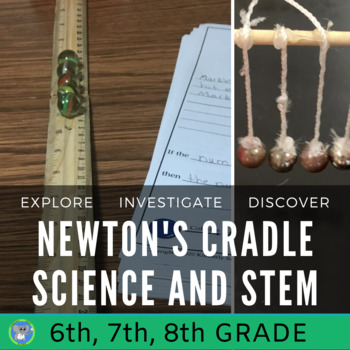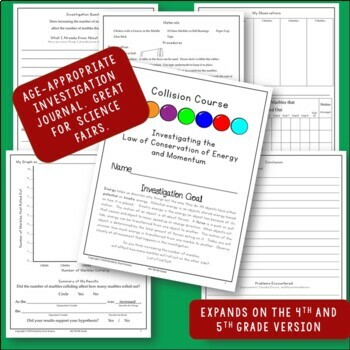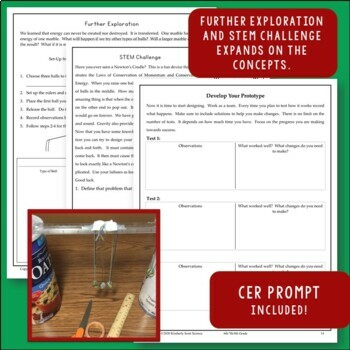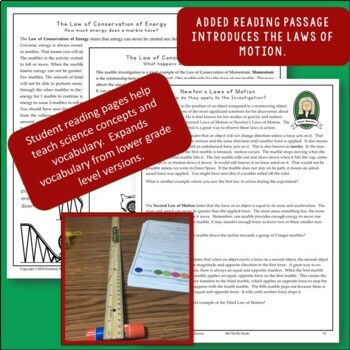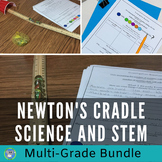Forces and Motion Unit | Newton's Cradle Science And STEM | Grade 6 7 8
- PDF
- Easel Activity
Also included in
- This bundle on force and motion offers various grade-level versions to cater to different learning levels. Simple supplies and low prep. Students explore, investigate, and engage in STEM activities to learn about the Law of Conservation of Energy and the Law of Momentum. The ultimate goal is to creaPrice $18.40Original Price $23.00Save $4.60
Description
Discover the Law of Conservation Energy and the Law of Conservation of Momentum with a fun marble collision science investigation. Simple supplies and EASY PREP. Expands to introduce The Laws of Motion. Explore further with an added exploration. Engage students in a STEM Challenge to create a Newton's Cradle. Includes extensive background information to guide the teacher and students to success.
This is a printable PDF. Please read more about Easel below.
Students will expand their knowledge of forces and motions by observing the transfer of potential energy to kinetic energy. Through hands-on learning, they will gain an understanding of The Law of Conservation of Energy and The Law of Conservation of Momentum. An additional reading passage explains how it relates to The Laws of Motion. Students will follow the scientific method, use CER, and follow the engineering design process to create a Newton's Cradle.
By the end of the activities, students will be able to answer the question:
Does increasing the number of marbles colliding affect the number of marbles that will roll out?
The journal meets the Next Generation Science Standards
- Middle-Level Motions and Stability: Forces and Interactions
- Middle-Level Energy
- Grade 6-8 Science and Engineering Practices
Teachers will appreciate the detailed background information and tips. It contains a clear outline of materials, a variety of activities, and is easy to follow. Choose to perform the whole unit or pick the activity that works best. Students will enjoy performing a hands-on activity, having time to explore, and becoming experts on energy transfer. Teachers will like how each activity builds on each other to give the students the knowledge to help them with the final STEM Challenge. A perfect week or two-week-long unit for teaching the conservation of energy and momentum. The middle-level unit expands the concept into The Laws of Motion.
This hands-on Investigation and Teacher guide includes:
- Alignment to NGSS Middle-Level Motions and Stability: Forces and Interactions
- Alignment to NGSS Middle-Level Energy
- Alignment to NGSS 6-8 Science and Engineering Practices
- Background Information for the teacher with science, vocabulary, and tips
- Collision Course Investigation Journal
- The Law of Conservation of Energy Student Reading Material
- The Law of Conservation of Momentum Student Reading Material
- Newton's Laws of Motion Student Reading Material (Only included in the middle-level version.)
- Further Exploration Activity with included CER page
- STEM Challenge Activity: Make a Newton's Cradle
- Anchor Charts (Blank and Filled in.)
- Rubric and Answer Keys
A pre-created template for Easel by TPT is included. Just click "Open in Easel" on the product page. You can modify it as needed. Please make sure you still download the PDF to see the complete teacher guide, tips for set-up, and TOU. This will allow you to perform a demo with virtual students while they complete it on their devices. It can also be an at-home activity with parents. Teachers can also use it to project the journal on the board for class discussions. We prefer to print the papers, but this gives you flexibility.
Supplies Needed
rulers, marbles, tape, glue sticks, cups, scissors, various size balls, and crafting materials for the STEM Challenge. (pipe cleaners, cardboard, string, balls, tape, hot glue, etc.)
Great for a classroom activity, STEM fair, science fair, science camps, after-school programs, clubs, scout groups, homeschool, and more.
This investigation is part of a series. Each is differentiated for abilities and the Next Generation Science Standards. If this is your first Kimberly Scott Science Journal, we recommend you start with the grade below. Each grade level expands on the other. K/1st grade completes 2 tests, simplifies the concept, and includes a further exploration and simple STEM Challenge. The 2nd/3rd-grade unit contains 3 levels and a choice of 1 or 5 trials. It provides more fill-in-the-blank and focuses on balanced and unbalanced forces. The 4th/5th-grade unit contains 4 levels and 7 trials. Students calculate the mean, create a graph, and write detailed conclusions. It expands to the conservation of energy and has more depth. The middle-level journal expands to 5 levels and 10 trials. Middle-level students are expected to write more and expand their thoughts. It expands to include momentum.
Forces And Motion Unit | Grade K And 1 | Marble Run Science And STEM
Forces And Motion Unit | Grade 2 And 3 Newton's Cradle Science And STEM
Forces and Motion Unit | Grade 4 And 5 Newton's Cradle Science And STEM
A bundle discount is available.
Forces and Motion Science and STEM Grade K-8 bundle - Create a Newton's Cradle
You might also like
Science Reading Comprehension: Sir Isaac Newton, Gravity, and Inertia
Inertia And Gravity Experiment: The Laws Of Motion for 4th/5th-Distance Learning
Newton's Laws Of Motion Poster
Remember leaving feedback earns you points toward FREE TPT purchases. We love hearing how the investigation went.
Also, follow us and be notified when new explorations are uploaded and deals.
Please contact us with any questions! We are here to help.
Yours in Science,
Kimberly Scott
All parts are copyrighted. Please see the Terms of Use in the download.

